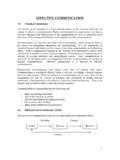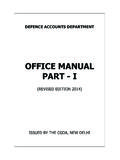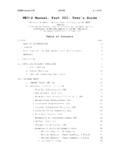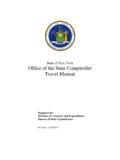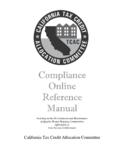Transcription of MANUAL OF OFFICE PROCEDURE - IMG Kerala
1 MANUAL OF OFFICE PROCEDURE . The MANUAL of OFFICE PROCEDURE is intended to serve as a guide for regulating OFFICE PROCEDURE in the OFFICE of the Heads of Departments. It can also be adopted for use in the regional, district or sub-offices of various Departments with suitable changes if necessary. Definitions: Tappal: All communications received in the OFFICE which are official, unofficial or demi-official are until registry known as tappal. Current: Communications received in the OFFICE which are distributed to the sections with the dated seal and a number is called the current. The number assigned to a current is called a current number. Case: A case consists of current file, note file and any previous papers and books put up for reference. Current file: Current file is that part of a case consisting of papers received, drafts of interim references, replies thereto and draft of final orders issued. It is arranged chronologically from top to bottom.
2 Note file: Note file is that part of a case which contains the notes written by clerks and other officers including the Director. It is written to facilitate the disposal of the case. Disposal: Disposal is the statement of the final decision of head of OFFICE on any case submitted for information and orders. Back file: The disposals containing decisions already taken put up for reference to processing fresh cases are called back files. Drafting: Drafting is the preparation of any communication which is proposed to be issued. Enclosure: A communication or a statement or a plan, sketch or other document which is attached to another communication to supplement or elucidate the point is called an enclosure. 1. Arising Reference: Any reference issued from the OFFICE which originates the file. Demi-Official correspondence: A correspondence is called Demi-Official when Govt. officers correspond with each other or with any member of the public on administrative or official matters without official formality and with a personal touch.
3 Flagging: Flagging is the process of attaching to the top of papers put up for reference in a case, slips with alphabetical letters. Linking: When one case has relevance in relation to another case, both the cases are submitted together and this process is called linking of files. Registry: A paper is said to be registered when it is given a current no. and entered with abstract in the PR. Referencing: Referencing is the process of putting up in a case, previous correspondence, laws, rules, reports etc. required for its disposal, flagging them and indicating the fact in the margin of the note file/current file. New case: A paper which is not connected with a pending case in the OFFICE or one which originates in the OFFICE is termed as a new case. Issue: A term used to denote the process of copying and despatching communications. Put up papers: Put up papers means the previous orders or other papers connected with or having a bearing on the subject of a current under consideration and put up with the current.
4 Official correspondence: A correspondence is called official when one Govt. officer addresses or is addressed by another Govt. officer or by any public body or private individual in writing in accordance with certain fixed rules as to form, matter and PROCEDURE and with the intention that such correspondence may be the public record regarding the question discussed. Section: The minor division of the OFFICE consisting of a Superintendent and one or more clerks. 2. Old Case: A reply to a reference issued from the OFFICE or a paper which though not a reply of that nature has for any other reason to be filed with the current already pending is called an old case. Tagging: The current and its enclosures are punched at the top left hand corner and a tag is passed through the hole. This process is called tagging. TAPPAL. All communication received in the OFFICE until numbering is known as tappal. It may be cards, envelopes, packets or telegram.
5 Tappal is received by the tappal clerk and acknowledged. Telegram received is sent to the concerned officer and he will give back the same to the clerk after opening. Tappal received after OFFICE hours are kept in a box. The same will be opened on the next day along with the tappal of that day. Tappal is opened in the presence of the Head OFFICE or authorized officer. The officer can make necessary instructions at that time on Tappal. The tappal is then date sealed, numbered and sorted section wise and entered in the Distribution Register by the tappal clerk. Then it is sent to the Section Superintendent for distribution to the concerned section clerks along with the Distribution Register. The concerned clerk acknowledges the tappal by taking the same after verifying the distribution register. Papers which need not be entered in DR. Telegraphic messages, tour programmes, spare copies, unstamped or insufficiently stamped petitions, papers wrongly addressed, applications which are not in the prescribed form, gazettes, printed pamphlets and publication need not be entered in the DR.
6 When valuables are received in OFFICE 1. Enter them in the Security Register by Tappal clerk. 2. Separate from the communications. 3. Hand over it to the Manager for safe custody after acknowledgement from the manager. 3. Stamp affixed petition 1. Defaced and punched by Tappal clerk. 2. Superintendent should see it is done. Urgent and telegraphic communications on Holidays 1. Those received on holidays and out of OFFICE hours will be sent to Head of OFFICE by special messenger. 2. Action should be taken on the day itself if necessary. Functions of OFFICE Section: The OFFICE section under the charge of an OFFICE Supdt. attends mainly to the receipt of papers, its distribution, despatch of outward communications, transmission of disposals to records, upkeep of specified registers, procurement and distribution of stationery etc. Personal Register: Currents to be acknowledged in the DR and registered in the Personal Register.
7 Only bound volumes to be used 10 columns. Name of the Superintendent and Clerk to the pasted on the cover. Superintendent to certify the register. New PR opened for every calendar year. Sufficient blank pages to be left to carry over pending files. All currents to be entered in the PR in the order of current number. Normally 3 entries in one page. Title/subject to be brief and clear. Nature of reference issued, reminders sent and received should be noted. Nature of disposal with date to be noted in red ink in column 10. When closed column(1) should be rounded off in red ink. Provide sufficient lines in the PR when protracted correspondence is anticipated only 1 or 2 entries in one page. If space is inadequate, paste slips. Delay or neglect in entering the currents in the PR amounts to dereliction of duty. Old cases need not be given Serial No. while registering in the PR. 4. Referencing: Referencing is a process of putting up in a case previous correspondence, rules, reports etc.
8 Required for its disposal, flagging them and indicating the fact in the margin of note file/current file/draft in which they are mentioned or quoted. Every paper quoted by its number and date in the current file should be put up. If it is in the current file, the page number may be indicated in pencil in the margin. If it is in a disposed file, it may be obtained from records and flagged and the relevant para and page number indicated in margin. For every statement made in the note file, an authority must be quoted. If it is in the current file, the page number may be quoted in the body of the note at the end of each sentence in brackets in pencil. If it is in a disfile, the old disposal is flagged and the disposal number, relevant page and para noted in the note file and its flag letter noted in pencil in the margin. Flagging: Every disposal files mentioned in the current file or note file to which a reference is made in the file, should be put up for reference with flags attached to the docket.
9 Flags should not be pinned to any page of the current file/note file. When there are more than one disposal for reference, flags should be attached in alphabetical order. There must be only one flag on a disfile. If there is more than one disposal, one flag should not cover another. Flags bearing the same letter should not again be attached to the disposals put up for reference in a file. Linking of files: Linking of files becomes necessary when a reference is made in a file to a paper or notes or orders in another pending file. The two files are then linked and attention invited to the concerned pages of the linked file. The principal file is kept above but its strings are tied below and the file referred to, is kept below and with its strings the two files are tied. The papers in the two files should remain unchanged. Files should not be linked unnecessarily. Linking should be made only if it is absolutely necessary for disposing of the case.
10 If possible, extracts from the other files can be taken and put up to avoid linking of files. If the two files contain similar issues, the two files can be combined into one. 5. Note file and Current file: A case or file consists of a note file, current file and put up papers, if any. Note file and current file are kept separate till disposal of the case. Current file is tagged to a blue fly leaf. Current file consists of communications received and references issued. Note file is separate and tagged to a yellow fly leaf. Note is written to facilitate the disposal of the case. A note is continued till a final decision is taken in the case. Noting: The aim of a note is to present the facts in the most intelligible, condensed and convenient form so that the decision taking authority may take a quick and correct decision. Past history of the case, precedents, if any etc. are to be mentioned in the note. Rules and regulations and standing orders relating to the case should be quoted and discussed briefly.

